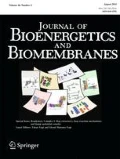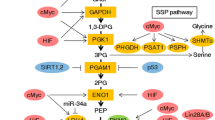Abstract
For more than two-thirds of this century we have known that one of the most common and profound phenotypes of cancer cells is their propensity to utilize and catabolize glucose at high rates. This common biochemical signature of many cancers, particularly those that are poorly differentiated and proliferate rapidly, has remained until recently a “metabolic enigma.” However, with many advances in the biological sciences having been applied to this problem, cancer cells have begun to reveal their molecular strategies in maintaining an aberrant metabolic behavior. Specifically, studies performed over the past two decades in our laboratory demonstrate that hexokinase, particularly the Type II isoform, plays a critical role in initiating and maintaining the high glucose catabolic rates of rapidly growing tumors. This enzyme converts the incoming glucose to glucose-6-phosphate, the initial phosphorylated intermediate of the glycolytic pathway and an important precursor of many cellular “building blocks.” At the genetic level the tumor cell adapts metabolically by first increasing the gene copy number of Type II hexokinase. The enzyme's gene promoter, in turn, shows a wide promiscuity toward the signal transduction cascades active within tumor cells. It is activated by glucose, insulin, low oxygen “hypoxic” conditions, and phorbol esters, all of which enhance the rate of transcription. Also, the tumor cell uses the tumor suppressor p53, which is usually modified by mutations to debilitate cell cycle controls, to further activate hexokinase gene transcription. This results in both enhanced levels of the enzyme, which binds to mitochondrial porins thus gaining preferential access to mitochondrially generated ATP, and in a decreased susceptibility to product inhibition and proteolytic degradation. Significantly, these multiple strategies all work together to enable tumor cells to develop a metabolic strategy compatible with rapid proliferation and prolonged survival.
Similar content being viewed by others
REFERENCES
Pedersen, P. L. (1978). Prog. Exp. Tumor. Res. 22, 190–274.
Warburg, O. (1930). The Metabolism of Tumors, Arnold Constable, London.
Van Eys, J. (1985). Annu. Rev. Nutrition 5, 435–461.
Weinhouse, S. (1972). Cancer Res. 32, 2007–2016.
Weinhouse, S. (1982). In Molecular Interrelationships of Nutrition and Cancer (Arnott, M. S., Van Eys, J., and Wang, J. M. eds.), Raven Press, New York, pp. 167–181.
Nakashima, R. A., Paggi, M. G., and Pedersen, P. L. (1984). Cancer Res. 44, 5702–5706.
Bustamante, E., and Pedersen, P. L. (1977). Proc. Natl. Acad. Sci. USA 74, 3735–3739.
Weber, G. (1982). In Molecular Interrelationships of Nutrition and Cancer (Arnott, M. S., Van Eys, J., and Wang, J. M. eds.), Raven Press, New York, pp. 191–208.
Arora, K. K., and Pedersen, P. L. (1988). J. Biol. Chem. 263, 17422–17428.
Kikuchi, Y., Sato, S., and Sugimura, T. (1972). Cancer 30, 444–447.
Nakashima, R. A., Paggi, M. G., Scott, L. J., and Pedersen, P. L. (1988). Cancer Res. 48, 913–919.
Thelen, A. P., and Wilson, J. E. (1991). Arch. Biochem. Biophys. 286, 645–651.
Rempel, A., Bannasch, P., and Mayer, D. (1994). Biochim. Biophys. Acta 1219, 660–668.
Mathupala, S. P., Rempel, A., and Pedersen, P. L. (1995). J. Biol. Chem. 270, 16918–16925.
Herzfeld, A., and Greengard, O. (1972). Cancer Res. 32, 1826–1832.
Nakashima, R. A., Mangan, P. S., Colombini, M., and Pedersen, P. L. (1986). Biochemistry 25, 1015–1021.
Parry, D. M., and Pedersen, P. L. (1983). J. Biol. Chem. 258, 10904–10912.
Mathupala, S. P., and Pedersen, P. L. (1995). Unpublished observations.
Johansson, T., Berrez, J.-M., and Nelson, B. D. (1985). Biochem. Biophys. Res. Commun. 133, 608–613.
Shinohara, Y., Ichihara, J., and Terada, H. (1991). FEBS Lett. 291, 55–57.
Wang, G. L., and Semenza, G. L. (1995). J. Biol. Chem. 270, 1230–1237.
Mathupala, S. P., Rempel, A., and Pedersen, P. L. (1996). FASEB J. 10, 2965.
Rempel, A., and Pedersen, P. L. (1995). Unpublished observations.
Rempel, A., Mathupala, S. P, and Pedersen, P. L. (1996). FEBS Lett. 385, 233–237.
Mathupala, S. P., Heese, C., and Pedersen, P. L. (1997). J. Biol. Chem 272, 22776–22780.
Rempel, A., Mathupala, S. P., Griffin, C. A., Hawkins, A. L., and Pedersen, P. L. (1996). Cancer Res. 56, 2468–2471.
Dang, C. V., Lewis, B. C., Dolde, C., Dang, G., and Shim, H. (1997). J. Bioener. Biomembr., 29, 345–354.
Author information
Authors and Affiliations
Rights and permissions
About this article
Cite this article
Mathupala, S.P., Rempel, A. & Pedersen, P.L. Aberrant Glycolytic Metabolism of Cancer Cells: A Remarkable Coordination of Genetic, Transcriptional, Post-translational, and Mutational Events That Lead to a Critical Role for Type II Hexokinase. J Bioenerg Biomembr 29, 339–343 (1997). https://doi.org/10.1023/A:1022494613613
Issue Date:
DOI: https://doi.org/10.1023/A:1022494613613




